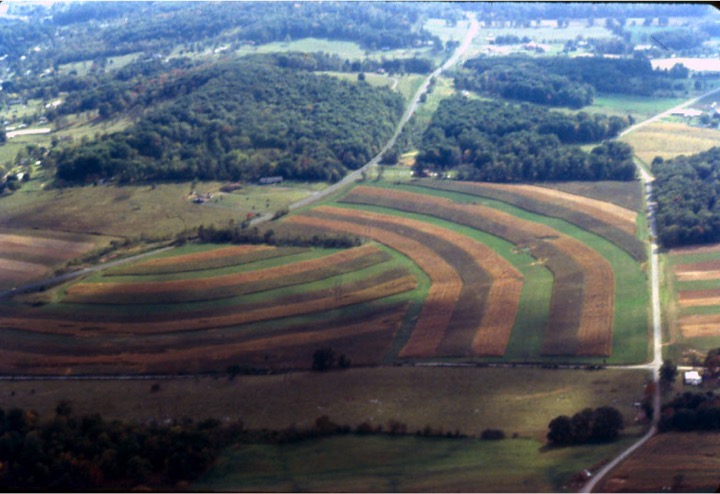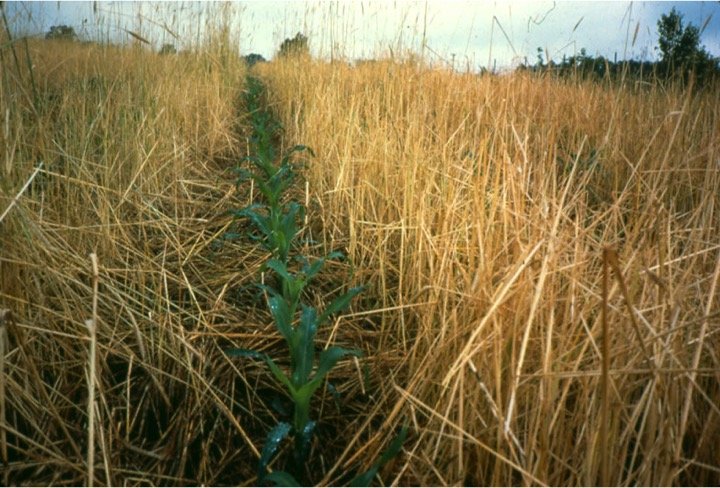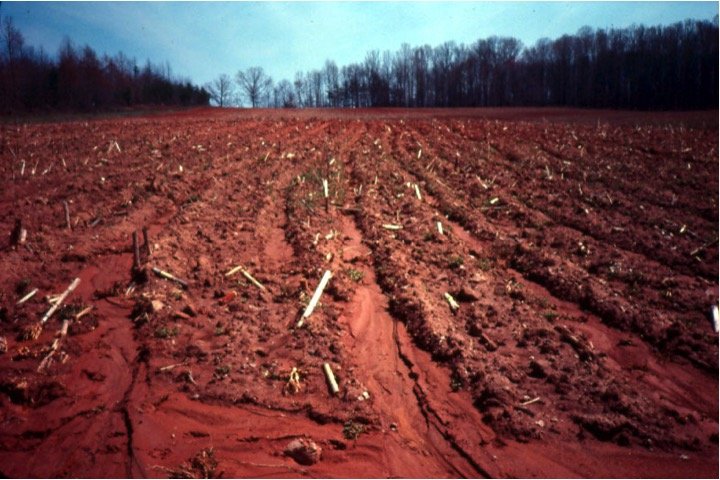In our quest to profit from the land and feed a hungry planet with annual crops such as corn and soybeans, we have abandoned one of the most powerful conservation practices known to science – contour farming. Used since ancient times to slow the flow of water across the land to make it soak into the soil, contour farming is a method of planting crops across the slope of the land or perpendicular to the flow of water.

This contour strip cropping system in Stuarts Draft Virginia incorporates many BMPs: contour farming, crop rotation, no-till planting, crop residue use, cover crops and perennial crops in rotation
Contour farming captures twice the soil moisture and reduces soil erosion up to eight-fold
The simple act of planting across the slope instead of up and down the hill does two very important things: it captures at least twice the rainwater and reduces soil erosion up to eight-fold.
I laid out many contour strip cropping systems in my career with the Natural Resources Conservation Service, formerly the Soil Conservation Service. When I was working in Augusta County, Virginia some of our soils were very erosive, one soil, Berks-Weikert had a very low tolerance for soil erosion at two tons per acre per year. We call this the soil’s “T” value. The science of soil conservation is to develop a cropping system below this value. If the cropping system is below the “T” value for the soil then we are building soil health. Above the “T” value means we are losing more soil than we are making which is not sustainable.
We can calculate the annual average soil erosion rate by using a formula agronomists call the Revised Universal Soil Loss Equation.
In the late 80’s and early 90’s I was working with a farmer in Stuarts Draft that had a lot of Berks-Weikert soil and it took every soil conservation measure we had to get his annual average soil erosion rate down to “T” or below. He installed a system using contour farming and alternating bands of crops and perennials. The picture above shows some of his contour, strip cropping systems.
The farmer believed in building soil health; he wanted zero erosion. Many years later this farmer sold his land and a new farmer bought it. The new farmer did not want the contour strips because it took more time plant. He wanted to plant the whole farm in one crop. He said he would use no-till and didn’t need to plant on the contour.
The new farmer destroyed years of soil building conservation
I did the calculations. His cropping system yielded an average soil erosion rate of 4 tons per acre per year. I informed him that he would not be building soil and eventually his soil resources would be exhausted. Unfortunately, the U.S. Farm Bill allows farmers to continue receiving USDA benefits as long as their soil erosion rates do not exceed 2 X “T”.
Bottom line: the new farmer has twice the soil erosion that agronomists know is sustainable and still receives USDA benefits.
I lamented as the strip cropping systems I laid out in Stuarts Draft were destroyed, replaced by a no-till, monoculture system.
With the coming of “no-till” farming, I witnessed farmers taking out their contoured, curving bands of crops and abandoning the practice of planting on the contour. It was much faster to just plant in the most expeditious manner whether it be up and down the hill or around and around the field, this at the expense of capturing more water which is a priceless asset for crops in July and August.
Farming is like making a fine cabinet; it takes a lot of tools: a table saw, planer, miter box, band saw, drill press etc. The cabinetmaker needs them all. A farmer planting annual crops on sloping land needs a lot of tools as well: no-till planter, cover crops, crop rotation, and…contour farming.
Like the table saw in building a cabinet; contour farming is one of the most important tools in building soil health.
In the 1938 Yearbook of Agriculture, “Soils and Men”, there is a table from an experiment where 11 inches of rain fell. The field that was planted on the contour captured 6.7 inches of the rain compared to only 2.1 inches from the non-contoured field.
In a letter to William A. Burwell in 1810, Thomas Jefferson wrote, “…we have had the most devastating rain which has ever fallen within my knowledge. Three inches of water fell in the space of about an hour. Every hollow of every hill presented a torrent which swept everything before it. I have never seen the fields so much injured. Mr. Randolph’s farm is the only one which has not suffered; his horizontal furrows arrested the water at every step till it was absorbed…Everybody in this neighborhood is adopting his method of ploughing, except tenants who have no interest in the preservation of the soil…”
In another letter to Charles W. Peale in 1813 he wrote, “We now plough horizontally following the curvatures of the hills and hollow, on the dead level, however crooked the lines may be. Every furrow thus acts as a reservoir to receive and retain the waters, all of which go to the benefit of the growing plant, instead of running off into streams”.
No-till farming is a great conservation practice but it is not the panacea of soil conservation. It takes a combination of conservation practices to anchor the soil and nutrients on the land where they belong – not washing away with rainfall into the streams where they become pollutants.
Runoff from agricultural fields is one of the largest contributors of pollution to the streams in the Chesapeake Bay watershed. Planting annual crops such as corn, soybeans and wheat have always had inherent risks for soil erosion and polluted runoff because they have to be planted every year. The steeper the land is, the more conservation measures need to be applied to the land to reduce erosion and increase the infiltration of water into the soil – contour farming achieves both.
To get help with contour farming and other Best Management Practices contact your local Soil and Water Conservation District or USDA office.



18 Comments
Leave your reply.